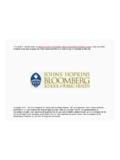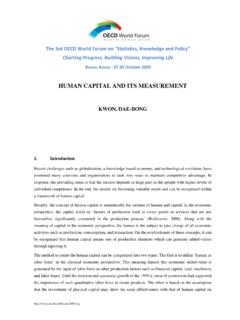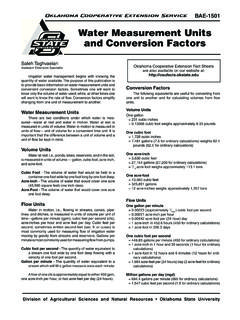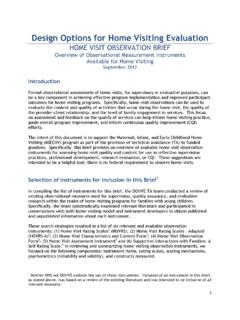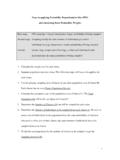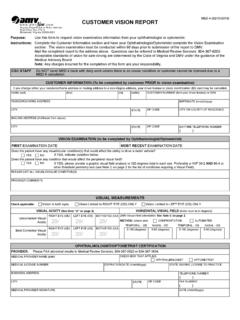Transcription of 19 MEASUREMENT UNCERTAINTY - US EPA
1 1 Planners and decisionmakers must also consider the variability of the analyte in sampled populations, as discussedin Appendix C; however, the focus of this chapter is on the UNCERTAINTY of measuring the analyte in each 2004 MARLAP19 MEASUREMENT OverviewThis chapter discusses the evaluation and reporting of MEASUREMENT UNCERTAINTY . Laboratorymeasurements always involve UNCERTAINTY , which must be considered when analytical results areused as part of a basis for making Every measured result reported by a laboratoryshould be accompanied by an explicit UNCERTAINTY estimate. One purpose of this chapter is to giveusers of radioanalytical data an understanding of the causes of MEASUREMENT UNCERTAINTY and ofthe meaning of UNCERTAINTY statements in laboratory reports.
2 The chapter also describes proce-dures which laboratory personnel use to estimate chapter has more than one intended audience. Not all readers are expected to have themathematical skills necessary to read and completely understand the entire chapter. For thisreason the material is arranged so that general information is presented first and the more tech-nical information, which is intended primarily for laboratory personnel with the required mathe-matical skills, is presented last. The general discussion in Sections and requires littleprevious knowledge of statistical metrology on the part of the reader and involves no mathe-matical formulas; however, if the reader is unfamiliar with the fundamental concepts and termsof probability and statistics, he or she should read Attachment 19A before starting Section technical discussion in Sections and requires an understanding of basic algebra andat least some familiarity with the fundamental concepts of probability and statistics.
3 The discus-sion of UNCERTAINTY propagation requiresknowledge of differential calculus for a com-plete understanding. Attachments 19C E areintended for technical specialists. The major recommendations of the chapterare summarized in Section The Need for UncertaintyEvaluationRadiochemical laboratories have long recog-nized the need to provide uncertainties withtheir results. Almost from the beginning, lab-oratories have provided the counting uncer-tainty for each result, because it is The Need for UNCERTAINTY Evaluating and Expressing MeasurementUncertainty .. Procedures for Evaluating UNCERTAINTY .. Radiation MEASUREMENT 19A: Statistical Concepts and Terms19-63 Attachment 19B: Example Calculations.
4 19-77 Attachment 19C: Multicomponent MeasurementModels ..19-83 Attachment 19D: Estimation of Coverage Factors ..19-85 Attachment 19E: Uncertainties of Mass and VolumeMeasurements ..19-93 MEASUREMENT Uncertainty19-2 MARLAPJULY 2004easy to evaluate (see Sections and ). However, the counting UNCERTAINTY is only onecomponent of the total MEASUREMENT UNCERTAINTY . Over the years it has been recommendedrepeatedly that laboratories perform good evaluations of the total UNCERTAINTY of each measure-ment. In 1980 the Environmental Protection Agency published a report entitled UpgradingEnvironmental Radiation Data, which was produced by an ad hoc committee of the HealthPhysics Society. Two of the recommendations of this report were stated as follows (EPA 1980).
5 Every reported MEASUREMENT result (x) should include an estimate of its overalluncertainty (ux) which is based on as nearly a complete an assessment as UNCERTAINTY assessment should include every conceivable or likely source ofinaccuracy in the recently ANSI , American National Standard MEASUREMENT and Associated Instru-ment Quality Assurance for Radioassay Laboratories, recommended that service laboratoriesreport both the counting UNCERTAINTY and the total propagated UNCERTAINTY . ISO/IEC 17025,General Requirements for the Competence of Testing and Calibration Laboratories, which wasreleased as a standard in 1999, requires calibration and testing laboratories to have and apply procedures for estimating MEASUREMENT uncertainties (ISO/IEC, 1999).
6 The National Environ-mental Laboratory Accreditation Conference (NELAC) has also published a standard on labora-tory quality systems, which requires a radiochemical testing laboratory to report with each resultits associated MEASUREMENT UNCERTAINTY (NELAC, 2002, ch. 5).Note that the concept of traceability (see Chapter 18) is defined in terms of UNCERTAINTY . Trace-ability is defined as the property of the result of a MEASUREMENT or the value of a standardwhereby it can be related to stated references, usually national or international standards, throughan unbroken chain of comparisons all having stated uncertainties (ISO, 1993a). Thus, a labora-tory cannot realistically claim that its MEASUREMENT results are traceable to a standard unlessthere exists a chain of comparisons, each with an associated UNCERTAINTY , connecting its results tothat chapter considers only MEASUREMENT UNCERTAINTY .
7 The claim is often made that field samp-ling uncertainties are so large that they dwarf laboratory MEASUREMENT uncertainties. Although theclaim may be true in some cases, MARLAP rejects this argument as an excuse for failing to per-form a full evaluation of the MEASUREMENT UNCERTAINTY . A realistic estimate of the measurementuncertainty is one of the most useful quality indicators for a the need for good UNCERTAINTY evaluation has long been recognized, not all laboratorieshave been able to implement the recommendations fully. A certain level of mathematical sophis-tication is required. Implementation requires, at a minimum, a mastery of basic algebra, someknowledge of differential calculus and a grasp of many concepts of probability and statistics; buteven more fundamentally it requires an understanding of the various aspects of the measurementMeasurement Uncertainty19-3 JULY 2004 MARLAP process in the laboratory, including chemical and physical principles as well as practical consid-erations.
8 Implementation at a laboratory is certainly easier if there are those who understand boththe MEASUREMENT process and the mathematical methods, but in some cases it may be necessaryto use a team approach that brings together all the required there is software that performs the mathematical operations for UNCERTAINTY evaluation andpropagation, and some of the difficulties of implementation may disappear as such softwarebecomes more widely available. Nevertheless analysts and technicians will still need to under-stand the concepts of MEASUREMENT UNCERTAINTY and how they apply to particular measurementprocesses in the Evaluating and Expressing MEASUREMENT UncertaintyThe methods, terms, and symbols recommended by MARLAP for evaluating and expressingmeasurement UNCERTAINTY are described in the Guide to the Expression of UNCERTAINTY in Meas-urement, hereafter abbreviated as GUM, which was published by the International Organizationfor Standardization (ISO) in 1993 and corrected and reprinted in 1995 (ISO, 1995).
9 The methodspresented in the GUM are summarized in this chapter and adapted for application to terminology and notation used by the GUM and this chapter may be unfamiliar or confusingto readers who are familiar with statistics but not metrology. Metrology (the science of measure-ment) uses the language and methods of probability and statistics, but adds to them its ownterms, symbols, and approximation MEASUREMENT , Error, and UncertaintyThe result of a MEASUREMENT is generally used to estimate some particular quantity called themeasurand. For example, the measurand for a radioactivity MEASUREMENT might be the specificactivity of 238Pu in a laboratory sample. The difference between the measured result and theactual value of the measurand is the error of the MEASUREMENT .
10 Both the measured result and theerror may vary with each repetition of the MEASUREMENT , while the value of the measurand (thetrue value) remains error may be caused by random effects and systematic effects in the measurementprocess. Random effects cause the measured result to vary randomly when the MEASUREMENT isrepeated. Systematic effects cause the result to tend to differ from the value of the measurand bya constant absolute or relative amount, or to vary in a nonrandom manner. Generally, both ran-dom and systematic effects are present in a MEASUREMENT Uncertainty2 In some performance-testing programs, the term bias is used to mean the difference between a laboratory smeasured result and the target value.










